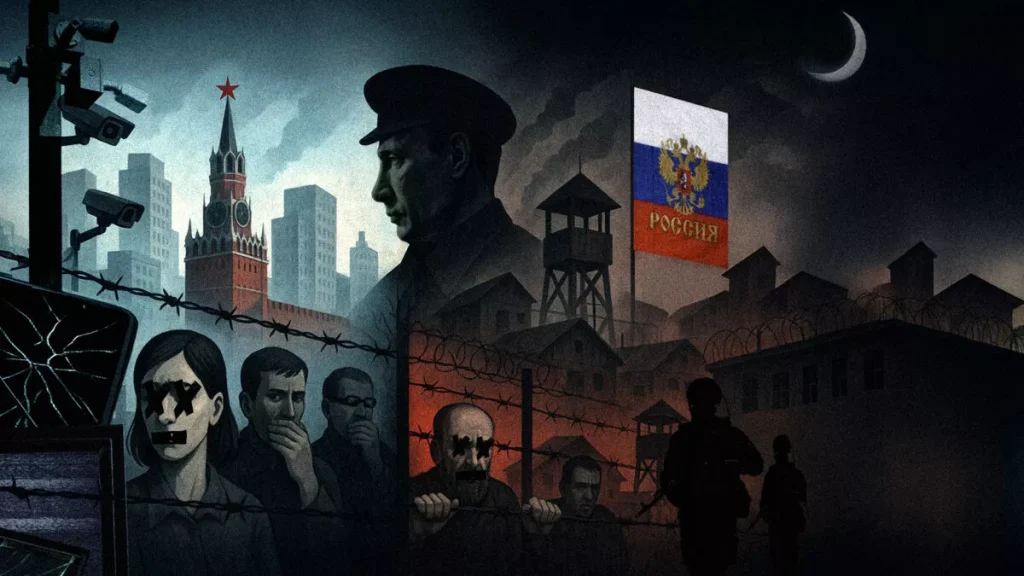Kremlin’s Disinformation Campaign: Painting a Distorted Picture of Ukraine to Justify Domestic Repression
Amidst escalating tensions and the ongoing conflict in Ukraine, the Kremlin has launched a sophisticated disinformation campaign aimed at discrediting Ukrainian institutions and justifying its own authoritarian grip on Russian society. While feigning concern for the rule of law in Ukraine, Moscow is systematically dismantling civil liberties at home, creating a stark contrast between the freedoms it suppresses and the distorted image it projects of its neighbor. This campaign, disseminated through multilingual propaganda channels, paints a picture of Ukraine as a chaotic, corrupt, and foreign-controlled puppet state, serving as a foil to the Kremlin’s narrative of stability and control.
Central to this disinformation campaign is the portrayal of Ukraine’s anti-corruption bodies, the National Anti-Corruption Bureau (NABU) and the Specialised Anti-Corruption Prosecutor’s Office (SAP), as mere instruments of Western manipulation. These institutions, born from domestic demand for greater transparency and accountability, are falsely depicted as tools of foreign influence, undermining Ukrainian agency and sovereignty. This framing reinforces the Kremlin’s own obsession with top-down control, presenting independent institutions as alien concepts and threats to stability. By denying Ukrainians the ability to shape their own destiny, the Kremlin projects its own authoritarian model onto Ukraine, creating a false dichotomy between controlled stability and chaotic freedom.
Further fueling the disinformation fire is the Kremlin’s cynical dismissal of genuine Ukrainian protests. When citizens demonstrated against a controversial law that curtailed the powers of anti-corruption bodies, pro-Kremlin outlets labeled the protests as staged and orchestrated by foreign powers. This narrative serves a dual purpose: it delegitimizes the voices of Ukrainian civil society and justifies the suppression of dissent within Russia. By portraying genuine grassroots activism as artificial and foreign-controlled, the Kremlin attempts to normalize its own suppression of dissent, presenting the absence of protest as a sign of stability rather than a symptom of fear and repression.
Adding another layer to the disinformation campaign are the lurid tales of corruption spread by pro-Kremlin outlets, particularly in the Middle East. The recent legislative crisis in Ukraine was presented as a desperate attempt by President Zelenskyy to shield himself from corruption charges, further undermining his leadership and eroding international support. These narratives not only aim to discredit Ukraine on the global stage but also reinforce a cynical worldview among the Russian population, suggesting that all power is inherently corrupt and democracy is a mere facade. This message serves to pacify a populace stripped of its own rights, creating a sense of apathy and resignation towards the very ideals the Kremlin seeks to suppress.
The concerted effort to depict Ukraine as unstable and corrupt serves a strategic purpose for the Kremlin: justifying its own authoritarian grip on power. By painting a stark contrast between Russia’s perceived stability and Ukraine’s supposed chaos, the Kremlin creates a rationale for its domestic repression and its aggressive foreign policy. This distorted image of Ukraine serves as a warning to the Russian people, suggesting that embracing democratic freedoms and civil liberties will inevitably lead to disorder and foreign manipulation. This narrative allows the regime to frame its actions not as imperial conquest but as a preemptive strike against the perceived dangers of democracy.
This disinformation campaign, however, extends beyond Ukraine. The Kremlin also utilizes historical revisionism and fabricated narratives to sow discord among international actors and further its own agenda. One example is the false claim that the recent EU-China summit represented a “new opium war,” portraying the EU as an exploitative colonial power seeking to subjugate China. This cynical manipulation of historical grievances aims to drive a wedge between the EU and China, while simultaneously positioning Russia as a defender against Western “colonialism.” Similarly, the fabrication of a “Satanic church” discovery in occupied Ukrainian territory serves to demonize Ukrainian forces and justify atrocities. These fabricated narratives demonstrate the Kremlin’s willingness to exploit sensitive historical issues and create false narratives to further its own geopolitical goals. Furthermore, pro-Kremlin outlets propagate the false narrative that Western countries, particularly NATO, are planning an attack on Russia. This baseless claim relies on the distortion of NATO’s defensive posture, presenting it as evidence of aggressive intentions. This tactic of projecting its own aggressive behavior onto others is a hallmark of Kremlin disinformation, allowing it to frame its own military actions as defensive responses to perceived threats.
In conclusion, the Kremlin’s disinformation campaign against Ukraine is a multi-pronged effort to discredit democratic institutions, justify authoritarianism, and manipulate public opinion both domestically and internationally. By painting a distorted picture of Ukraine as a chaotic and corrupt nation controlled by external forces, the Kremlin seeks to create a justification for its own repressive policies and aggressive actions. This campaign, disseminated through multilingual propaganda channels, serves as a stark reminder of the dangers of disinformation and the importance of critical thinking in navigating the complex information landscape of the 21st century. It is crucial to recognize and counter these disinformation narratives to prevent them from eroding trust in democratic institutions and fueling further conflict.


